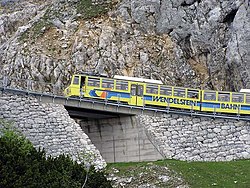Wendelsteinbahn
| Wendelsteinbahn | |||||||||||||||||||||||||||||||||||||||||||||||||||||||||||||||||||||||||||||||||||||||||||||||||||||||||||||||||||||||||||||||||||||||||||||||||
|---|---|---|---|---|---|---|---|---|---|---|---|---|---|---|---|---|---|---|---|---|---|---|---|---|---|---|---|---|---|---|---|---|---|---|---|---|---|---|---|---|---|---|---|---|---|---|---|---|---|---|---|---|---|---|---|---|---|---|---|---|---|---|---|---|---|---|---|---|---|---|---|---|---|---|---|---|---|---|---|---|---|---|---|---|---|---|---|---|---|---|---|---|---|---|---|---|---|---|---|---|---|---|---|---|---|---|---|---|---|---|---|---|---|---|---|---|---|---|---|---|---|---|---|---|---|---|---|---|---|---|---|---|---|---|---|---|---|---|---|---|---|---|---|---|---|
|
The Wendelsteinbahn when passing the "High Wall"
| |||||||||||||||||||||||||||||||||||||||||||||||||||||||||||||||||||||||||||||||||||||||||||||||||||||||||||||||||||||||||||||||||||||||||||||||||
| Route number : | 9570 | ||||||||||||||||||||||||||||||||||||||||||||||||||||||||||||||||||||||||||||||||||||||||||||||||||||||||||||||||||||||||||||||||||||||||||||||||
| Course book section (DB) : | 11030 | ||||||||||||||||||||||||||||||||||||||||||||||||||||||||||||||||||||||||||||||||||||||||||||||||||||||||||||||||||||||||||||||||||||||||||||||||
| Route length: | total: 7.66 km, with rack: 6.15 km |
||||||||||||||||||||||||||||||||||||||||||||||||||||||||||||||||||||||||||||||||||||||||||||||||||||||||||||||||||||||||||||||||||||||||||||||||
| Gauge : | 1000 mm ( meter gauge ) | ||||||||||||||||||||||||||||||||||||||||||||||||||||||||||||||||||||||||||||||||||||||||||||||||||||||||||||||||||||||||||||||||||||||||||||||||
| Power system : | 1500 V = | ||||||||||||||||||||||||||||||||||||||||||||||||||||||||||||||||||||||||||||||||||||||||||||||||||||||||||||||||||||||||||||||||||||||||||||||||
| Maximum slope : | 237 ‰ | ||||||||||||||||||||||||||||||||||||||||||||||||||||||||||||||||||||||||||||||||||||||||||||||||||||||||||||||||||||||||||||||||||||||||||||||||
| Minimum radius : | 40 m | ||||||||||||||||||||||||||||||||||||||||||||||||||||||||||||||||||||||||||||||||||||||||||||||||||||||||||||||||||||||||||||||||||||||||||||||||
| Rack system : | Strub | ||||||||||||||||||||||||||||||||||||||||||||||||||||||||||||||||||||||||||||||||||||||||||||||||||||||||||||||||||||||||||||||||||||||||||||||||
|
|||||||||||||||||||||||||||||||||||||||||||||||||||||||||||||||||||||||||||||||||||||||||||||||||||||||||||||||||||||||||||||||||||||||||||||||||
Two mountain railways lead to the Wendelstein in the Upper Bavarian Limestone Alps , the original Wendelsteinbahn, an electrically operated, meter-gauge rack railway with some adhesion sections , and the Wendelstein cable car . Both are operated by Wendelsteinbahn GmbH. The cog railway overcomes a difference in altitude of 1217.27 meters. In addition to the Bavarian Zugspitzbahn , the Drachenfelsbahn and the Stuttgart rack railway , the Wendelsteinbahn is one of only four rack railways still in operation in Germany. It is a listed building.
concept
The construction of the Wendelsteinbahn was the vision of Otto von Steinbeis , an industrialist who, in addition to forestry and agriculture in the foothills of the Alps, operated logging in Bosnia on a large scale and at the same time built an extensive network of small trains. In 1908 he published his plans and on February 4, 1910, Prince Regent Luitpold signed the concession document for the construction of the Wendelstein cog railway.
The route, originally 9.95 kilometers long, from Brannenburg largely over the eastern flank of the mountain has seven tunnels, eight galleries and twelve bridges. Avalanche barriers exist over a length of 514 meters . In order to maintain operations in winter, instead of the topographically less problematic route on the slopes of the Mitter and Reindler Alms, a more complex route along the steep rock faces of the Wildalpjoch and the Soins was chosen.
construction
After overcoming various obstacles and difficulties, construction began on March 29, 1910. The construction costs amounted to around three million gold marks , which the builder paid entirely from his own resources.
Over two years around 800 workers, mostly from Bosnia and Italy, worked under the most difficult conditions. For the so-called High Wall alone , a 127 meter long and 17 meter high dam just before the mountain railway station, 10,000 cubic meters of hewn stone were used. A total of 35 tons of explosives were used.
On May 12, 1912, the first train officially ran the entire route and on May 25, the railway was inaugurated. The Wendelsteinbahn is the oldest active rack railway in Bavaria.
business

In 1922, a railway carriage derailed in the gallery in the Raindler basin. More than 30 injuries were the result.
The journey time for the previous entire route was 75 minutes. With increasing individual traffic, the section between Brannenburg station and today's valley station in the Brannenburg district of Waching was given up on December 21, 1961 because it crossed the main road. In addition, the journey on the roughly two-kilometer long friction route cost a few minutes of travel time, which was needed for more efficient operations. In addition, it was not possible to create a sufficiently large parking lot in Brannenburg. With the abandonment of the "valley route", however, the connection to the network of the former German Federal Railroad was also dropped ; however, even then only ten percent of the passengers on the Wendelsteinbahn traveled by train. The journey time was shortened with a route length of now 7.66 kilometers to 55 minutes.
In the following years it became clear that profitable operation of the railway was not possible. Therefore, in 1970, the Wendelstein cable car was built from Bayrischzell- Osterhofen to the Wendelstein summit , which was to replace the rack railway in the long term. However, the attraction of the cog railway for tourism was recognized and its operation was maintained.
With the help of the Free State of Bavaria , the neighboring communities, the district of Rosenheim and the parent company Lechwerke AG, the system was modernized from 1987 for 17 million DM . The completion of the work in 1991 was associated with a capacity increase of almost 100 percent. The travel time was reduced to 25 minutes for the ascent and 35 minutes for the descent thanks to two modern double multiple units. Since then, the trains have been running every half hour. Today around 20 employees still work at the cog railway, but the railway is still dependent on compensation payments.
power supply
A separate hydropower plant was built next to the Wimbauchau depot for rail operations. The operating company also acts as a regional energy supplier .
Web links
- Wendelsteinbahn GmbH Brannenburg
- Vehicle list of the Wendelsteinbahn GmbH
- Pictures of the tunnel portals of the Wendelsteinbahn
- 100 years Wendelsteinbahn: Yellow train, green soul , article by Detlef Berg in Spiegel Online , May 14, 2012
Individual evidence
- ^ Bavarian State Office for Monument Preservation ( Memento from March 4, 2016 in the Internet Archive )
- ↑ Tooth for tooth there's more for the eye. In: Frankfurter Allgemeine Zeitung . April 3, 2012, p. T6
- ^ The first cogwheel railway in Bavaria was the paper mill in Kinsau am Lech, which opened in 1907 ; however, it was shut down in 1929. The oldest still active cog railway in Germany is the Drachenfelsbahn, which went into operation on July 13, 1883.
- ^ Hans Joachim Ritzau: Railway disasters in Germany. Splinters of German history . Vol. 1. Landsberg-Pürgen 1979, p. 38.
- ↑ S. Bufe: rack railways in Bavaria. Munich 1977, p. 8
- ↑ S. Bufe: rack railways in Bavaria. Munich 1977, p. 10
- ↑ https://www.wendelsteinbahn.de/information








